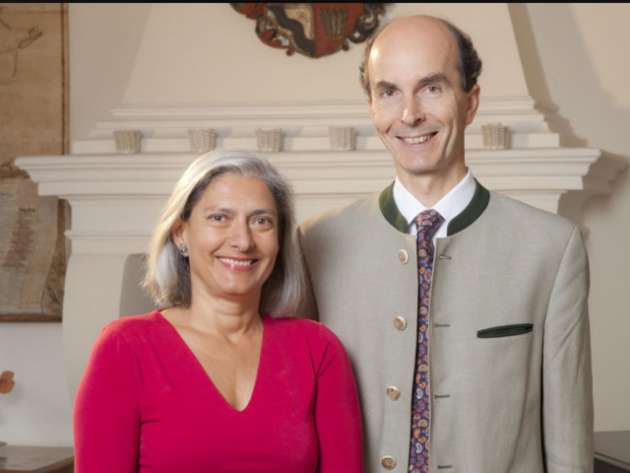
Romania's Restituted Wineries show the way
The American writer Thomas Wolfe famously warned “You can't go home again”.
But what if Wolfe was wrong?
Ileana Costinescu left her Romanian homeland in 1969, just as Nicolae Ceausescu was getting started on bringing about the economic and humanitarian catastrophe that would lead, fatefully, to his execution 20 years later. She set about starting a new life for herself in the west, where she met Tyrolean Baron Jacob Kripp, became Baronin Ileana Kripp and started what is now a large extended family.
But fate has a way of bringing things full circle. When Jacob Kripp learned in 1997 that Romania's post-communist government was restituting vineyards back to former owners, he came to the Prince Stirbey vineyard in the Dragasani, a run down region bisected by the River Olt and once Romania's premier wine producing region. The winery was founded in its current form by Illeana's grandfather Prince Barbu Alexandra Stirbey, though the family has owned vineyards for 300 years here.
“I came and immediately told Illeana that we have to try and get this back. This place is so beautiful. And she agreed. Yes, I think for her it was a sense of coming back home to a country she thought she had lost forever,” says Kripp, looking across the vines to the winery and the River Olt below.
“There was a lot of goodwill when we arrived here. People had been keeping things going during the bad times and really wanted us to succeed,” says Kripp.
Illeana admits that returning to Romania – even if it is for just part of the year – has been emotionally challenging.
“You almost need psychotherapy,” adds Ileana.
But it's been worthwhile.
Prince Stirbey is now back to producing around 100,000 bottles a year, close to what it was historically. There are plans to increase this – the old early 20th century building has seen major investment in stainless steel tanks and oak barrels - but the focus will remain on quality. Though not yet organic, the winery works with minimal intervention, making the most of the loam and sandstone soil.
“We now make 26 wines out of eight different varieties, with the focus on single varieties, so we can let each one speak for itself,” says winemaker Oliver Bauer, who started at Stirbey in 2003.
The focus remains local indigenous grapes – which here means white Cramposie, Feteasca Regala and Tamaioasa Romaneasca and red Novac and Negru de Dragasani – with the Kripps and Bauer reckoning these perform better in the terroir and have greater sales potential, particularly in export markets.
“We are never going to make the world's best Merlot or Sauvignon Blanc but we have a chance, at least, of making the world's best Cramposie or Negru de Dragasani,” quips Kripp.
On tasting, it would seem that the team is doing a fine job. They make Cramposie as a sparkling wine – aged for 52 months on the lees - which works very well, the variety's appley-accidity making this a good aperitif wine. Another success is the Tamaioasa Romaneasca 2016 (Wine Society), which is deliciously rounded and fruit driven, the variety keenly displaying its relation to Muscat.
And the reds are a wonder; the Novac 2015 (Wine Society), a variety created in 1987 by crossing Georgia's native variety Saperavi with local variety Negru Vartos, is aged for 14 months in 300 litre barrels and is full on, with a wonderfully complex cassis-driven nose. Meanwhile the Negru de Dragasani 2016 (Oddbins) is very accessible, the lack of wood enabling this versatile Syrah-like variety to show its full range of flavours.
Just down the road, some 20 years ago Christiana Stoica, a business lawyer, returned to the property founded by her great grandparents in 1927, determined to help resurrect Dragasani's reputation for making quality wine, Avincis now has 42 hectares producing 150,000 bottles, which should rise to 200,000 “within the next few years”, with the focus also on native varieties.
Clearly, a lot of money has gone into this property, which boasts a stunning new winery resembling an Aztec temple, a renovated family manor house and visitor apartments. An Italian consultant winemaker ensures the wines – which are in three price/quality ranges, with the Avincis label as the main premium brand - are as they should be.
“I'm hopeful that others will come but many people don't have the time or patience,” says Stoica.
Or indeed, the money. Kripp points out that setting up a winery requires at least €7-8m with lots of know how needed, a problem in Romania where technical knowledge can be hard to find.
And then there is finding markets.
“At wine fairs, we used to find ourselves next to Thailand but quality has improved, as has Romania's image,” he says, adding that if you look at a wine map of Romania here are lots of white gaps.
“Austria has what, seven million people and over 5000 wineries? Here we have 250 wineries for 20 million people, despite great climate and soil conditions. There is lots of potential,” he concludes.
Keywords:
- native grapes
- Romanian
- Baronin Illeana Kripp
- Baron Jacob Kripo
- wine Romania
- Restituted Wineries
- Prince Storey
- Dragasani
- Cramposie
- Feteasca Regala
- Tamaioasa Romaneasca
- Novac
- Negru de Dragasani
- Christiana Stoica




